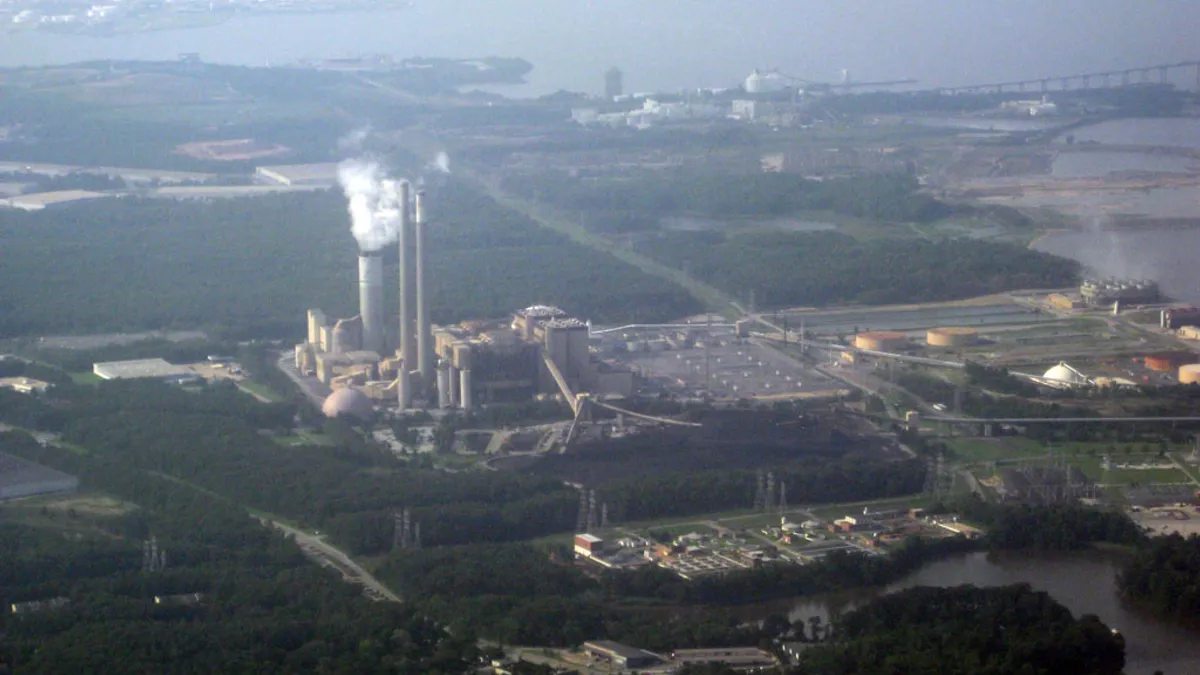Dive Brief:
- Starting in mid-2025, the PJM Interconnection’s recent capacity auction could increase electricity bills in Maryland by 2% to 24%, depending on location, according to a report released Wednesday by the state’s ratepayer advocate.
- Ratepayers in the Baltimore Gas and Electric “locational deliverability area” could see their bills increase an additional 5%, for a total increase of 19% — or about $250 a year for residential customers and nearly $2,700 for commercial customers — to cover reliability-must-run contracts aimed at keeping two Talen Energy power plants from shutting down, the study prepared for the Maryland Office of People’s Counsel by Synapse Energy Economics found.
- Maryland, a net electricity importer, needs new transmission lines and generating plants, according to PJM. “The Maryland [OPC] knows all of this to be true, and these critical issues deserve a better discussion than ongoing exercises in finger pointing,” Susan Buehler, a PJM spokeswoman, said in a statement. “We look forward to working with the Maryland OPC, as we do all our stakeholders, on continuing to enhance our markets, transmission planning and generation interconnection processes.”
Dive Insight:
Consumers across PJM’s Mid-Atlantic and Midwest footprint will pay $14.7 billion for capacity in the 2025/26 delivery year, up from $2.2 billion in its auction last month, the grid operator said July 30.
For the majority of the PJM region, capacity prices for the 2025/26 delivery year soared to $269.92/MW-day, up from $28.92/MW-day in the last auction, the grid operator said in an auction report. Prices hit zonal caps of $466.35/MW-day for the BGE zone in Maryland, and $444.26/MW-day for the Dominion zone in Virginia and North Carolina.
The auction results will cause electric bill increases across Maryland’s four PJM zones, according to Synapse. Ratepayers in the Allegheny Power System zone in Western Maryland, which includes part of Potomac Edison’s service territory, will see a 24% bill increase, the consulting firm found. The capacity auction results will increase bills by 10% in the Pepco zone, which includes part of Pepco’s footprint and Southern Maryland Electric Cooperative, and by 2% in the Maryland portion of the Delmarva Power South zone, according to Synapse.
The main driver for the rate increase in the BGE zone are the RMR contracts for Talen’s Brandon Shores and Wagner power plants, which the company had planned to retire in mid-2025, according to the report. Under the contracts, the power plants will continue operating until transmission lines are built to address the area’s reliability issues — which PJM expects will occur by the end of 2028.
Power plants with RMR contracts don’t participate as supply-side resources in capacity auctions, which reduced the amount of available capacity in the BGE zone and drove up capacity prices there, according to Synapse.
The RMR contracts for the Talen power plants likely drove up capacity prices across PJM by about $5 billion, Synapse said.
PJM typically holds capacity auctions to ensure it has enough power supplies three years ahead of time. However, the auction schedule has been disrupted and the grid operator is in the process of returning to an annual schedule. The next auctions are set to be held in December and June for the delivery years starting in mid-2026 and mid-2027.
It is unclear how long capacity prices will remain high in PJM, in part because of the grid operator’s clogged interconnection queue, which could hamper power plant development, according to Synapse.
“The clogged queue could lock in a windfall for the existing generating units continuing to operate in the BGE LDA and across the PJM region generally,” the consulting firm said.
The price spike in the last auction was mainly driven by power plant retirements, planned shutdowns like those of Talen, increased load and new market rules, according to PJM.
The capacity prices in Maryland reflect the need for power lines and power supplies, according to PJM.
Last year, PJM received power plant “deactivation notices” totaling nearly 2.7 GW in Maryland, according to a PJM infrastructure report on the state and the District of Columbia. Maryland and D.C. had about 11.2 GW of installed capacity at the end of 2023, according to the report.
PJM’s interconnection queue in Maryland totals about 7.3 GW, including 3.9 GW of storage, 3.2 GW of solar and 45 MW of gas-fired generation, according to the report.
Last year, Maryland was a net importer of between roughly 2 GW and 4 GW throughout most of the year, PJM said in the report. At the same time, the grid operator expects winter peak loads to grow across Maryland in the next decade, including by 4.7% a year in the Allegheny zone and by 0.8% annually in the BGE zone.
“There is no debate, Maryland needs energy infrastructure,” PJM’s Buehler said. “Maryland needs generation to produce power for and transmission to move power to the customers that need it.”
PJM has reformed its interconnection process, and is quickly processing projects, according to Buehler.
“Yet, Maryland itself has very few prospective generation projects in the near term interconnection process,” she said. “Maryland policymakers should analyze why and what can be done to encourage development.”














